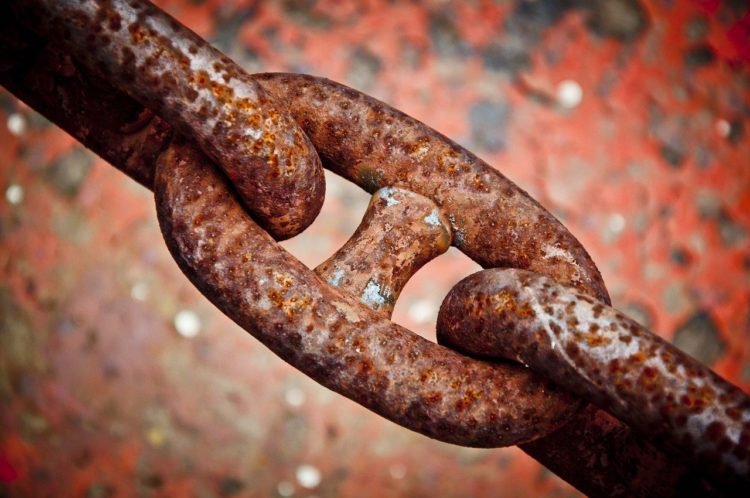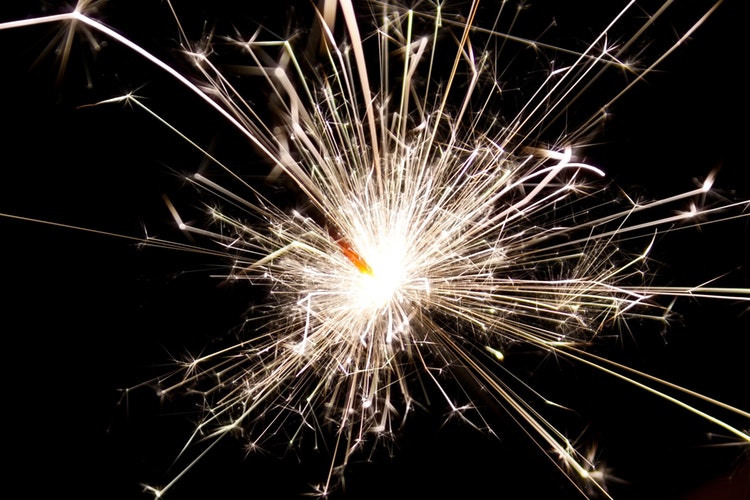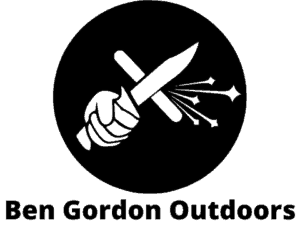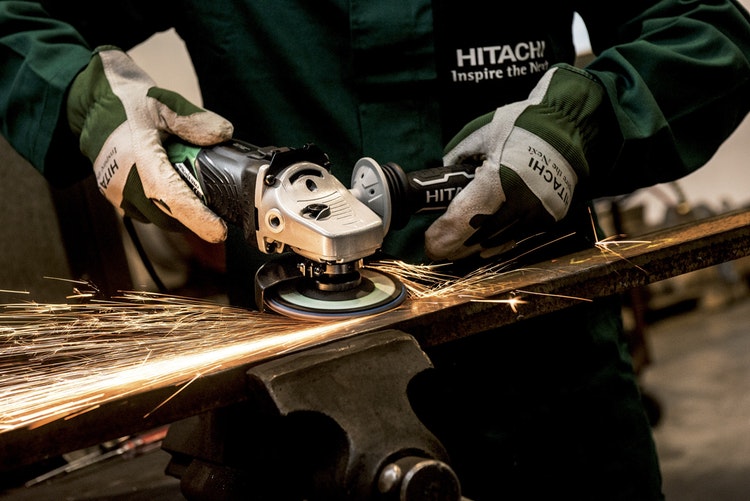Perhaps you’ve heard (maybe even from me) that flint can’t throw a spark from stainless steel knives. The other day, I was doing some experiments in anticipation of shooting a video, and realized that I could not throw sparks off my hatchet with flint, which greatly surprised me.
As it turns out, a good spark will only come from steel that is the right hardness, has a good carbon content, and isn’t too corrosion resistant.
Table of Contents
What makes Hot Sparks?
Most of the sparks the modern outdoor enthusiast is familiar with come from ferrocerium rods, which are not the focus of this article (if you’re in the market, I really recommend a thick, beefy model like this one). A ferro rod can be scraped with anything sharp and hard enough, like the spine of any kind of knife, a piece of flint, or even a shard of glass.
The sparks made by flint and steel come from the steel, not the flint. They’re tiny, white-hot flakes of steel, shaved off by the flint.
Those sparks are heated three different ways, each playing an important part in getting the steel flakes up to heat.
Impact Energy
First comes the energy from the impact of flint on steel, scraping our tiny shavings loose. The kinetic (motion) energy of the impact is absorbed by the metal, converting to heat. This doesn’t contribute a ton, but every little bit helps
Friction
Just as you can rub your hands together vigorously to produce heat, the friction of air over small particles flying at high speeds adds to the heat.
A very small piece of steel flying at high speeds is like a space shuttle on re-entry, heating up just by bumping and rubbing against air molecules.
This alone isn’t quite enough to give us that nice glowing spark, but it certainly helps.
Corrosion

The rest of the heat comes from corrosion, or rust.
That’s right, rust makes heat. In the scale of our everyday lives, the heat produced by steel rusting is negligible, but that all changes when you get small.
One interesting twist of physics is that the forces that dominate interactions depend on the scale involved. As particles get smaller, their volume to surface area ratio also shrinks, driving surface forces to dominate over body forces.
As long as there’s no phase change, like melting or boiling, the energy it takes to change the temperature of an object depends on the mass and material.
In our case, this means the effect of corrosion (a surface phenomenon) becomes more important, as smaller bits of steel have less mass to resist the temperature change.
Flaking off a small piece of steel exposes fresh surfaces to oxygen, rusting them quickly as they fly along. A surprising amount of the heat of sparks comes from this source.
What Drives Steel Spark Quality?

Hardness
Both the friction and corrosion effect require small chunks of steel flying quickly through the air. The steel needs to be in the right hardness range to make these small flakes happen.
Steel comes in both “mild” and “hardenable” varieties, each with their own purpose. Mild steel is great for structures, as you can really abuse its heating and cooling preferences without much fear. Hardenable steel (usually higher in carbon content) is good for tools, as you can shape it while soft, then heat treat it to set it hard.
You harden steel by heating it up hot enough to allow the carbon molecules to move more freely in the steel, which changes the structure to the very hard martensite form. If you let it just cool down slowly, it will relax back down to normal soft steel, but if you quench it, cooling it quickly, the carbon is frozen in place.
That hardened steel is now very brittle and very hard. Most uses, like knives, don’t need all that hardness, and would rather have a little less hardness to scale down the brittleness. Knives are tempered, heated some of the way back up to let the molecular structure relax. This softens the material and makes it less likely to snap.
But, you don’t want a soft edge. So often the blade is left harder than the spine as a sort of compromise. That soft spine is liable to just mush out of the way when you try to flake off sparks.
As described in this article by the late Ragnar of Ragweed Forge, a Rockwell Hardness of at least about 60 is required to throw the right kind of chips for sparks.
There’s probably some theoretical upper limit to the Rockwell Hardness that would work, but the practical limit is the hardness of your flint. Do note that chert, obsidian, jade, glass, or anything else that gives good sharp edges and is harder than your steel will work in place of the flint.
Carbon Content

Key: (A) High-carbon steel (B) Manganese steel (C) Tungsten steel (D) Molybdenum steel
Image Source: Wizard191 / Public domain
Carbon doesn’t just help steel to harden, it helps your sparks pack more punch too.
That added carbon ups the “sparkle” of sparks – rather than shooting in a straight line and burning out, sparks from medium- and high-carbon steel fizz like miniature fireworks throughout their travel.
It’s actually quite a common practice to identify unknown steels by spark testing, throwing sparks off the material and watching their flight. By comparing to known samples, an unlabeled piece can be identified fairly well, especially in a shop that only uses a few types of steel.
The diagram above shows the fizz of steel with medium or higher carbon content.
Starting a fire from sparks requires that your tiny flecks of hot steel come in contact with fine, dry tinder. A single spark has less opportunity to find just the right spot to put down stakes than a whole cluster of sparks thrown off a tiny explosion. That sparkle ups your odds, in addition to being flashy.
Corrosion Resistance
Given that the last bit of heat we need comes from rust, it should come as no surprise that steels specifically formulated to avoid rust don’t work well for flint and steel.
This is why stainless steel won’t spark well for us, and neither will several other classes of steel. 4140 steel is a pretty common, tough steel used in axles and striking tools, including many axes and hatchets. 4140 is high in chromium and molybdenum, added specifically to prevent corrosion.
If you check out some spark test charts, especially photo-based ones like the above poster from Hobart on Amazon, you will see sparks from stainless and chrome-moly steels, but they’re not very bright or aggressive.
These charts are based on using powered grinders, which throw off sparks at higher speeds than you can with flint, picking up extra help from the added friction.
You might be able to start a fire with these steels, but it’s much easier to just plan on using something more amenable.
How to Pick a Knife for Sparks
Remember, this is all based on using your knife as the source of sparks. Most any knife worth carrying will be able to throw sparks off a ferro rod, either with a sharp edge of the spine, or by scraping with the sharp edge (not recommended, but neither is freezing to death with a ferro rod in your hand).
You have two options: pick a knife that will throw sparks and be more susceptible to rust, or one that is less likely to rust, but won’t throw sparks.
I personally opt for the first option, and just take good care to keep my knives clean and dry. I use a carbon steel Morakniv Companion (the heavy duty option, as I baton with it regularly) for my larger knife, and keep a carbon steel Opinel No 6 (the smallest one with the ring lock) for my fine folder.
Unfortunately, not many knife manufacturers list their Rockwell Hardness, though some of the better ones do. Recall that differential tempering can leave the spine softer than the edge, so you may end up flaking sparks off your sharp edge in a pinch.
Asking around online can often kick up someone who knows the Rockwell Hardness of a given knife.
Why didn’t my Hatchet Spark?
My hatchet didn’t throw sparks for two reasons: hardness and corrosion resistance.
My hatchet is probably made from some close Swedish equivalent to the American 4140 steel I mentioned earlier, and the pole is very soft.
I just carved gouges in it, rather than flaking off sparks.
The lesson here is an old one: always, ALWAYS test anything you plan to rely on before you need to rely on it. I was absolutely sure my hatchet would throw sparks, until I gave it a try and saw that it didn’t.
If you’re looking for more info on Primitive Fire Skills, check out my article on that topic!


